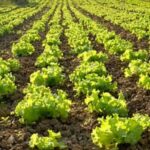Perlite is a popular gardening aid known for its ability to improve soil drainage and aeration. Gardeners use it as an additive in potting mixes and soil to promote healthier plant growth.
However, the question “Is Perlite safe for vegetable gardens” is often raised due to concerns about its chemical composition and potential impact on plant health. In this article, we will explore the safety of using Perlite in vegetable gardens, addressing misconceptions, examining its environmental impact, and offering best practices for incorporating Perlite into your gardening routine.
Perlite is a naturally occurring volcanic glass that expands when heated, creating tiny air pockets within the material. This lightweight, porous substance is widely used in horticulture to enhance soil structure and improve water retention.
While Perlite offers many benefits for plants, some gardeners have expressed uncertainty about its safety, particularly when used in vegetable gardens where the produce will be consumed. Understanding the potential risks and benefits of using Perlite in vegetable gardens is crucial for making informed decisions about its use.
In the following sections, we will delve into the chemical composition of Perlite to better understand how its components interact with plants. We will also address common misconceptions surrounding the safety of using Perlite in vegetable gardens and provide best practices for incorporating it into your gardening routine. Additionally, we will examine the environmental impact of Perlite and its effects on soil and plant health to help you make educated choices when considering this gardening aid.
Understanding the Safety of Perlite
Perlite is a versatile and lightweight material commonly used in gardening to improve soil drainage, aeration, and moisture retention. But is perlite safe for vegetable gardens? This is a common question among gardeners who are concerned about the potential risks and benefits of using perlite in their vegetable plots.
When it comes to the safety of using perlite in vegetable gardens, there are several factors to consider. One of the main concerns is whether perlite contains any harmful chemicals or substances that could leach into the soil and affect the health of edible plants. Another aspect to explore is how perlite interacts with plant roots and whether it provides a suitable growing environment for vegetables.
To address these concerns, it’s essential to understand the chemical composition of perlite. Perlite is an amorphous volcanic glass that contains small amounts of naturally occurring components such as silicon dioxide, aluminum oxide, and water. These components are inert and do not pose any known health risks to humans or plants. In fact, perlite is widely regarded as safe for use in organic gardening practices and is approved for use in certified organic farming.
To provide further reassurance to gardeners, there have been numerous case studies and research conducted on the safety of using perlite in vegetable gardens. These studies have consistently shown that perlite can enhance soil structure, promote healthy root growth, and increase yields in vegetable crops without posing any significant risk to plant or human health.
When used according to best practices, such as proper handling and application techniques, perlite can be a valuable tool for improving soil quality in vegetable gardens.
| Chemical Component | Safety Information |
|---|---|
| Silicon Dioxide (SiO2) | Considered inert and safe for use in organic gardening |
| Aluminum Oxide (Al2O3) | Naturally occurring component with no known adverse effects on plants or humans |
| Water (H2O) | Present in minimal amounts; does not contribute to soil moisture-related issues |
Chemical Composition of Perlite
Perlite, a popular gardening aid, is a naturally occurring volcanic glass that is heated to expand and form lightweight, white particles. Its primary use in gardening is as a soil amendment to improve aeration and drainage. It is often used in soilless potting mixes for seed starting and container gardening.
The chemical composition of perlite primarily consists of silicon dioxide, or silica, which is a non-toxic compound found in many natural substances. Additionally, perlite contains small amounts of aluminum oxide and iron oxide. These components are inert and do not pose any known risks to plants or humans when used as intended.
When incorporated into the soil, perlite helps improve its structure by increasing porosity and preventing compaction. This allows for better oxygenation of the root zone, leading to healthier plant growth. The lightweight nature of perlite also makes it easy to mix with soil and move around the garden as needed.
When using perlite in vegetable gardens, it is important to ensure that you are using a high-quality product that has been properly processed. Low-quality perlite may contain impurities or excessive dust, which can be harmful to plants. It is also recommended to wear gloves and a mask when handling perlite to avoid any irritation from the fine particles.
In summary, the chemical composition of perlite consists of non-toxic compounds that benefit plant growth by improving soil structure and aeration. When used responsibly, perlite is safe for vegetable gardens and can contribute to healthy and thriving crops.
Common Misconceptions
Many gardeners have concerns about the safety of using perlite in their vegetable gardens. There are some common misconceptions and misinformation that can make people hesitant to use this gardening product. It’s important to address these myths and provide accurate information about perlite’s safety for vegetable gardens.
One common misconception is that perlite contains harmful chemicals that can leach into the soil and affect the quality and safety of vegetables grown in it. In reality, perlite is a naturally occurring volcanic glass that is mined and then processed into a lightweight, porous material. It does not contain any harmful chemicals or toxins that could pose a risk to plants or humans.
Another myth surrounding perlite is that it can harm beneficial soil organisms such as earthworms and microorganisms. However, perlite is inert and sterile, meaning it does not contain any living organisms or pathogens that could harm soil health. In fact, its lightweight nature can improve soil aeration and drainage, creating a healthier environment for beneficial organisms to thrive.
Misinformation about the dustiness of perlite is also a concern for some gardeners. While perlite can generate dust when dry, this can be easily mitigated by dampening the material before use or mixing it with other ingredients. By following best practices for handling and incorporating perlite into the garden, such as wearing a dust mask during application and avoiding windy conditions, any potential issues related to dustiness can be minimized.
– Using Perlite in Vegetable Gardens:
- Use high-quality, horticultural grade perlite
- Mix perlite with potting mix or soil at a ratio of 1:4
- Avoid inhalation of dust by wearing protective gear during handling
With accurate information and proper usage, it is clear that perlite is safe for vegetable gardens.
- Maintain good ventilation when working with dry perlite
- Store unused perlite in a cool, dry place away from children and pets
- Avoid overwatering potted plants containing perlites to prevent waterlogging
Best Practices for Using Perlite in Vegetable Gardens
When it comes to using perlite in your vegetable garden, there are certain best practices that can help ensure its safe and effective use. From preparing the soil to proper application techniques, here are some tips and techniques for safely incorporating perlite into your gardening routine.
Preparing the Soil
Before adding perlite to your vegetable garden, it’s important to properly prepare the soil. This means removing any debris, weeds, or rocks, and loosening the soil to improve aeration and drainage. Once the soil is prepared, you can then mix in the appropriate amount of perlite based on the needs of your specific plants.
Proper Application Techniques
When incorporating perlite into your vegetable garden, it’s essential to use proper application techniques. This includes evenly mixing the perlite into the soil to ensure that it is distributed throughout the planting area. Avoid layering or clumping the perlite, as this can create uneven drainage and lead to potential issues with water retention.
Monitoring Plant Health
After incorporating perlite into your vegetable garden, it’s important to monitor the health of your plants closely. While perlite is generally considered safe for use in vegetable gardens, some plants may have sensitivities or specific needs that should be taken into account. Keep an eye on how your plants are responding to the addition of perlite and make adjustments as needed.
By following these best practices for using perlite in your vegetable garden, you can safely incorporate this versatile gardening aid into your routine while maximizing its benefits for plant health and growth.
Environmental Impact
Perlite is a popular gardening additive that is commonly used to improve soil aeration and drainage in vegetable gardens. But many gardeners may wonder, “Is perlite safe for vegetable gardens?” It’s important to understand the environmental impact of perlite and how it affects soil and plant health.
One of the key benefits of using perlite in vegetable gardens is its eco-friendliness. Perlite is a naturally occurring volcanic glass that is mined and processed with minimal environmental impact. It is also non-toxic and does not release any harmful substances into the soil or groundwater. This makes perlite a sustainable choice for gardeners who are conscious of their environmental footprint.
When added to soil, perlite helps to create air pockets that improve drainage and prevent compaction. This allows plant roots to access oxygen more easily, promoting healthy growth and reducing the risk of root rot. Additionally, perlite does not decompose over time, so it can be reused in multiple growing seasons, further reducing waste and environmental impact.
Research has shown that incorporating perlite into vegetable garden soil can lead to higher yields and improved plant health. Its use has been especially beneficial in heavy clay or compacted soils, where aeration and drainage are poor. When combined with compost or other organic matter, perlite can create a fertile growing medium that supports robust plant growth without the need for chemical fertilizers.
Overall, it is clear that perlite is a safe and eco-friendly option for vegetable gardens. Its ability to improve soil structure, promote healthy plant growth, and reduce environmental impact makes it a valuable addition to any gardening routine.
| Benefits of Perlite | Environmental Impact |
|---|---|
| Improves soil aeration | Naturally occurring with minimal environmental impact |
| Enhances drainage | Non-toxic and does not release harmful substances |
| Promotes healthy plant growth | Reduces waste by being reusable |
Case Studies and Research
When considering the safety of perlite for vegetable gardens, it is important to look at scientific studies and real-life experiences to understand its impact on plant health and the environment.
Scientific Studies
There have been several scientific studies conducted to evaluate the safety and efficacy of using perlite in vegetable gardens. These studies have looked at the interactions between perlite and plant growth, as well as the potential for any harmful effects on soil and water systems.
Many of these studies have found that perlite can be safely used in vegetable gardens, providing benefits such as improved soil aeration and drainage without causing any negative impacts on plant health or the surrounding environment.
Real-Life Experiences
In addition to scientific studies, many gardeners have shared their real-life experiences with using perlite in their vegetable gardens. These anecdotal accounts often mirror the findings of scientific research, with many gardeners reporting positive results from incorporating perlite into their gardening practices. From improved soil structure to healthier plant growth, these real-life experiences provide further evidence that perlite can be a safe and beneficial addition to vegetable gardens.
It is important to note that while both scientific studies and real-life experiences generally support the safety of using perlite in vegetable gardens, it is always wise to follow best practices and guidelines for its use. This includes using high-quality perlite from reputable sources, following recommended application rates, and monitoring plant health and soil conditions when using this additive in your garden.
Conclusion
In conclusion, the safety of perlite for vegetable gardens is a topic that has been thoroughly explored in this article. After examining its chemical composition and debunking common misconceptions, it is clear that perlite is indeed safe for use in vegetable gardens. The benefits of using perlite as a soil amendment, such as improved aeration and moisture retention, far outweigh any potential risks.
Gardeners can confidently incorporate perlite into their gardening routine by following best practices such as wearing protective gear during handling and avoiding inhalation of dust particles. Additionally, the eco-friendliness of perlite further solidifies its suitability for use in vegetable gardens, as it contributes to healthier soil and plant growth without harming the environment.
Based on case studies and research presented in this article, it is evident that many gardeners have experienced positive results from using perlite in their vegetable gardens. This further reinforces the safety and efficacy of using perlite as a soil amendment. Therefore, it is recommended that gardeners continue to use perlite in their vegetable gardens while adhering to best practices to ensure safety for both themselves and the environment.
Frequently Asked Questions
How Do You Use Perlite in a Vegetable Garden?
Perlite is commonly used in vegetable gardens as a soil amendment to improve drainage and aeration. It can be mixed into the soil or added to potting mixes to create a light, fluffy texture that allows for better root growth and moisture retention.
What Are the Disadvantages of Perlite?
One of the main disadvantages of perlite is that it is not a sustainable resource, as it is mined from specific volcanic rock deposits. Additionally, it can float to the surface of the soil over time, which may not be ideal for all types of gardening.
Should I Put Perlite in My Raised Beds?
Adding perlite to raised beds can be beneficial if the soil tends to become compacted or waterlogged. However, it’s important to consider the specific needs of the plants being grown, as some may not thrive in soils with excessive drainage. It’s always best to assess the existing soil composition and tailor amendments like perlite accordingly.

If you’re looking to get into vegetable gardening, or are just looking for some tips on how to make your current garden better, then you’ve come to the right place! My name is Ethel and I have been gardening for years. In this blog, I’m going to share with you some of my best tips on how to create a successful vegetable garden.





